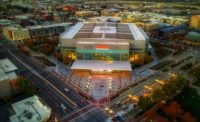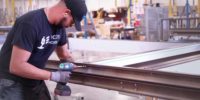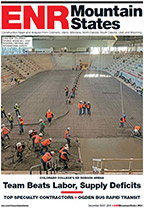U.S. Engineering Co. has emerged as a regional and national leader in the efficient offsite prefabrication of mechanical components and in the multi-trade collaboration needed to assemble them.
The Colorado offices of the mechanical contractor have recently tackled some of the state's largest and most complex health care projects. Those include a $47.6-million contract working with general contractor Haselden Construction at the University of Colorado Hospital (UCH) New Inpatient Tower and Critical Care Wing Expansion in Aurora, Colo., and a $76.8-million contract to provide mechanical contracting for Mortenson Construction at the Exempla St. Joseph Heritage Hospital in Denver.
On both jobs, U.S. Engineering's fabrication teams worked in rented warehouse space near the jobsites to assemble modular components that were then transported to the sites and installed fully intact, saving time and money.
"Prefabrication is not new, of course," says Mike Paulus, U.S. Engineering's vice president of operations. "But at University Hospital, we took it to the next level with multi-trade fabrication. We found solutions that were new to the region."
Paulus, who manages the firm's large projects portfolio, says at UCH the fabrication teams included electricians, drywallers, plumbers and pipefitters who assembled and delivered complete, framed bathroom units in an assembly line setup, with all components in place other than the tile finishes. Crews also fabricated utility corridor racks in 20-ft lengths built to meet seismic standards and customized to handle the building's non-linear corridors and existing deflections, Paulus says. The 144 corridor racks, 24 to a floor, were installed on five floors and carry central utility services throughout the building.
Other prefabricated components at the UCH project included the headwalls with medical gas connections for patient and exam rooms, all assembled, inspected and tested off site, then connected by crews at the site. The project was completed in July and won several awards, among them AGC of Colorado's ACE Project of the Year honors.
The Fabrication Advantage
"Sometimes it's hard to put savings for the prefabrication portion of a project in straight dollar terms," says Dan Strait, U.S. Engineering's vice president of project development. "You still have to build the same units so the component costs may be comparable, but it's a huge time saver." And, he adds, it improves safety, helps the ergonomic health of employees who can work on components at more manageable heights and cuts down on jobsite congestion and trash.
"At UCH, it probably kept 140 to 160 people off site, compressed activities and pulled the schedule forward," Paulus says.
But the fabrication process requires a high level of collaboration among the trades and strong communication and trust between the specialty contracting team and the designers.
"You absolutely can't do this without a significant company investment in BIM [building information modeling]," says Paulus. U.S. Engineering has 28 to 30 BIM professionals on staff and continually upgrades its BIM capabilities to keep up with its design-assist role on many projects, he says.
"We approach projects with an IPD [integrated project delivery] attitude, a 'draw-it-once' approach," Strait adds. "We try to avoid the redraw step and cut down on using multiple software platforms that don't always communicate with each other. We communicate with the engineers and then put the design directly into our software. But that requires developing very close relationships and trust with your engineers." It also helps both engineers and contractors see both sides of the task and helps with budget and constructibility, Strait adds.
The firm took its experience from the UCH project and refined those processes at St. Joseph Hospital, an ongoing project in central Denver scheduled for completion late next year. At the hospital, prefabrication is helping Mortenson cut the project schedule by 10-12 weeks.
The multi-trade fabrication team, which also includes Denver's Encore Electric, assembled the patient bathrooms, which are complete down to the shower curtains. The 166 multi-trade racks were assembled off site in four weeks, along with 376 patient headwalls.
The team held numerous "prefabrication charettes" during design, Strait says, which included U.S. Engineering and other key trades to help meet the accelerated schedule. Out of the 640 bathrooms in the hospital, 440 are being delivered as modular pods, with 15 standard designs to accommodate slightly different alignments.











Post a comment to this article
Report Abusive Comment